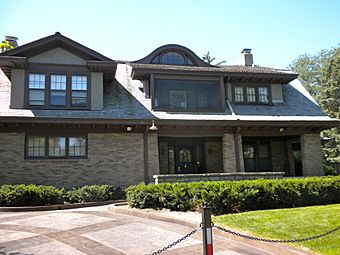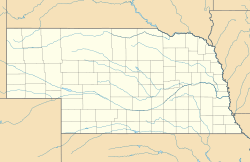Dundee–Happy Hollow Historic District facts for kids
Quick facts for kids |
|
|
Dundee–Happy Hollow Historic District
|
|

The home of Warren Buffett which he bought for $31,500 in 1958
|
|
| Location | Omaha, Nebraska |
|---|---|
| Architect | Thomas Rogers Kimball; John and Alan McDonald; others |
| Architectural style | Late 19th And 20th Century Revivals, Late 19th And Early 20th Century American Movements |
| NRHP reference No. | 05000726 |
| Added to NRHP | July 22, 2005 |
The Dundee–Happy Hollow Historic District is a special neighborhood in Omaha, Nebraska. It's known for its beautiful old homes and friendly community. This area is located west of Midtown Omaha, Nebraska. It stretches between Harney Street on the south and Hamilton Street on the north. Happy Hollow Boulevard is on the west, and 46th Street is on the east. The main part of Dundee is around 50th and Underwood Avenue. Dundee was started in 1880 and became part of Omaha in 1915. It's famous for being the home of Warren Buffett, a very successful investor. Other famous people like cartoonist Jeff Koterba and filmmaker Alexander Payne also lived here. Even actor Henry Fonda once called Dundee home!
Contents
History of Dundee
This neighborhood was first developed in 1880. Many people called it Omaha's first suburb. A suburb is a smaller town or area just outside a big city.
How Dundee Started
Two brothers, the Shannon Brothers from Kansas City, helped build the first homes. They built six houses between 48th and 52nd Street. Unlike other new neighborhoods where houses often looked the same, the homes in Dundee were built to be unique.
In 1888, a local newspaper, the Omaha Herald, wrote about the neighborhood's rules. These rules said that buildings had to be for homes only. They also had to be at least 25 feet away from the street. Each house needed to cost at least $2500. The rules also said that homes could not be used for any bad or against-the-law activities.
At first, the houses didn't sell very well. So, the developers worked to make Dundee feel like its own small village. They planted 2,000 maple trees along the streets. One street was even named Underwood after one of the developers. In 1905, a developer named Luke Toot O'Keefe offered free land if someone built a house. If they stayed for more than a year, they got an extra $500! This made many more people interested. The neighborhood then grew to include areas south of Dodge Street and north of Cuming Street.
Later, C.C. and J.E. George designed Happy Hollow Boulevard. They developed the area south of Dodge and west of 50th Street. They even filled in a creek that ran along 50th Street. They also added sidewalks and special Dundee lights. Homes in this area often looked like old European styles, such as Colonial, Georgian, and Tudor. Omaha officially made Dundee part of the city on June 20, 1915. At that time, it was about 0.7 square miles and had 2500 people living there.
A Special Bombing During World War II
In April 1945, during World War II, something unusual happened in Dundee. A Japanese fire balloon exploded over the neighborhood. The Japanese military sent these balloons across the ocean to cause problems in American cities. However, the American military kept this story a secret until after the war ended. Luckily, no one was hurt in the explosion.
Education in Dundee
This central Omaha neighborhood has several schools. Dundee Elementary School is part of the Omaha Public Schools district. Brownell-Talbot School is a historic private school. St. Margaret Mary's school is the local Catholic school. In 2006, St. Margaret Mary's was named the city's best private school. It received the "Blue Ribbon Award." Harrison Elementary School is also nearby and part of the Omaha Public Schools. Most children from these elementary schools go on to Lewis & Clark Middle School. After that, they attend Omaha Central High School. The area is also known for its many beautiful old houses.
Parks and Fun Places
Dundee is home to two major parks: Memorial Park and Elmwood Park. Many churches are also in the neighborhood. These include St. Margaret Mary Catholic Church and Dundee Presbyterian Church. Warren Buffett attended and was married at Dundee Presbyterian Church.
The area also has many local businesses. Some popular spots are the Dundee Dell restaurant and the Dundee Theatre. You can also find Blue Line Coffee Shop, Exist Green Zero Waste Market, and the Underwood Bar. And don't forget eCreamery Ice Cream and Gelato for a sweet treat! The Dundee-Memorial Park Association helps to promote and protect this special area. St. Margaret Mary Catholic Church and its school are very proud of their neighborhood. Every year, Dundee hosts "Dundee Day." This event features a neighborhood festival and a dance showdown.
Warren Buffett, who is sometimes called the "Oracle of Omaha," lives in Dundee. He bought his house for $31,500 in 1958. That would be about $340,000 today! His home is on the corner of Farnam and 55th Street. As of late 2023, the average price for a home in Dundee was about $379,544.
The Dundee Community Garden is a shared space for everyone. It's located at 49th and Underwood. People can get a small plot of land to plant their own vegetables for a small fee. Garden members also often share free vegetables from the community beds with people in need.
A Great American Place
In 2011, the Dundee-Memorial Park district was named one of the "Great American Places" by the American Planning Association. This award recognized the neighborhood's active and lively community. The community has worked on plans for a streetcar. They also want to get a special "National Register" status for their historic area.
The community also started a program to "adopt-a-streetlight." This helps restore 328 old cast-iron streetlights. They also pushed to be named a "neighborhood conservation and enhancement district." This helps protect the area's history and beauty. The neighborhood offers many different styles of architecture. It also has two important parks in Omaha, Nebraska.
The city has also made big efforts to improve daily life in the neighborhood. They set aside $550,000 to improve traffic, add more parking, and make the streets nicer. The Dundee Neighborhood Conservation-Enhancement District Plan has also helped protect a two-block area for historical preservation.



